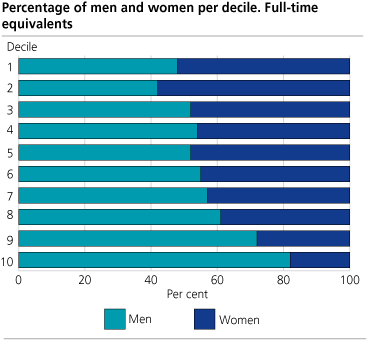Content
Published:
This is an archived release.
4.8 per cent increase in Norwegian wages
Average monthly earnings for Norwegian part- and full-time employees was NOK 30 600 per 3r d quarter 2006. This was an increase of NOK 1 400, or 4.8 per cent from the previous year.
In order to compare wage-levels for full- and part-time employees full-time wage levels are estimated for part-time employees. This is called full-time equivalents.
Unchanged wage gap
Women’s wages as a percentage of men’s was 84.7 per cent in 2006. Monthly earnings were NOK 27 700 for women, and NOK 32 700 for men. The wage difference is amongst other reasons explained by women’s choice of occupation, education and sector. Men are commonly in jobs that require higher education, as leaders and in the private sector, while a larger percentage of women work part-time in the public sector.
In figure 1, all employees are sorted by ascending monthly earnings. Men are significantly better represented in the top five groups, and more than 80 per cent of the best paid employees are men. On the other hand, women are overrepresented in two bottom groups.
While public sector employees had average monthly earnings of NOK 29 300 in 2006, private sector employees had monthly earnings of NOK 31 100. The average wage increase has been close to identical between sectors. There are however differences as to the distribution of the increase. When looking at the lower and upper quartile among private sector employees, there is a tendency that monthly earnings increase more in the latter. Among public sector employees there is less variation in growth, and the wage dispersion is wider. As a consequence, publicly employed women increase more than women in the private sector.
Private sector occupations
Craftsmen and elementary occupations experienced the smallest increase in monthly earnings in 2006, measured in both relative and absolute numbers. Craftsmen had NOK 800 more than the year before, while elementary occupations increased by NOK 700. This constituted 3.1 and 3.0 per cent respectively.
With monthly earnings of NOK 47 300 in 2006, leaders had NOK 2 400 or 5.3 per cent more than the year before. More than NOK 500 of this increase was due larger bonus payments.
Wage and education
Employees with primary or secondary education had average monthly earnings of NOK 24 800 in October 2006. Average monthly earnings normally increase with education level. For employees who have finished upper secondary education an additional NOK 4 000 is added to their monthly earnings compared to those with only primary or secondary education. Employees with tertial education, four years or less, had monthly earnings of NOK 34 100. In comparison employees with tertial educational, more than four years, had monthly earnings of NOK 43 200.
Wages in Norway and other European countries
As a part of the statistical cooperation within the EU, a survey of earnings is conducted in all membership countries. Norway equally contributed to this survey due to the EEA-agreement. The purpose of the survey is to establish comparable wage statistics for all countries and for variables like occupation, education, industry, sex and age.
Figure 4 shows nominal annual wage and purchase power parity (PPP) annual wage for full-time employees in industry in 2005. The figure, which covers the Nordic countries, Germany and EU, shows that Iceland has the highest nominal wage level. Compared to Sweden the wage level on Iceland is nearly 50 per cent higher. Germany has the highest PPP annual wage level, while Sweden and Finland have both the lowest nominal and PPP annual wage level.
About the statistical basisThe statistics are based on information from a sample of enterprises with a total of 1 395 865 employees per third quarter 2006. It covers all sections except for agriculture, hunting and forestry. The data for this statistics have not been collected separately, but is an assembly of previously published statistics for the individual sections. According to preliminary figures from the National Accounts for the 3rd quarter 2006, the statistics cover about 2 124 700 employees. The figures for 2005 are corrected. |
Tables:
- Table 1 Average monthly earnings by sector, working hours and sex per 3rd quarter 2006. Full-time equivalents. NOK
- Table 2 Average monthly earnings by sector, working hours and sex per 3rd quarter 2005. Full-time equivalents. NOK
- Table 3 Average monthly earnings for full-time equivalents, by working hours and section per 3rd quarter 2006 NOK
- Table 4 Average monthly earnings for full-time equivalents, by working hours and section per 3rd quarter 2005. NOK
- Table 5 Average monthly earnings and percentage change per 3rd quarter 2005-2006. Quartiles, median and mean, by sector
- Table 6 Average monthly earnings by sector, sex and working hours per 3rd quarter 2005 and 2006. NOK
Additional information
Contact
-
Arbeidsmarked og lønn
E-mail: arbeidsmarked@ssb.no
-
Knut Snellingen Bye
E-mail: knut.snellingen.bye@ssb.no
tel.: (+47) 40 81 13 26
-
Magnus Berglund Johnsen
E-mail: magnus.johnsen@ssb.no
tel.: (+47) 40 90 23 75
-
Fredrik Steinrem Edelmann
E-mail: fredrik.edelmann@ssb.no
tel.: (+47) 40 90 24 60
-
Knut Håkon Grini
E-mail: knut.grini@ssb.no
tel.: (+47) 48 20 51 63




